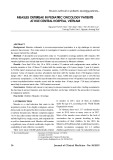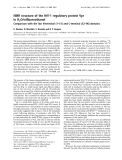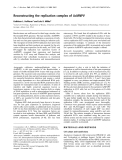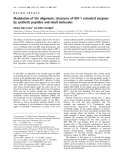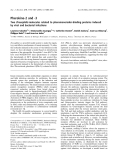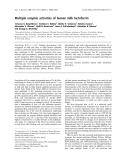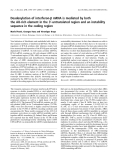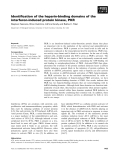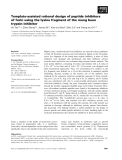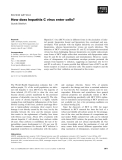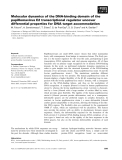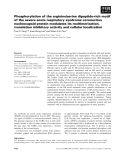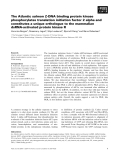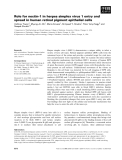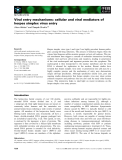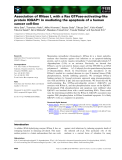
Viral infection
-
Measles outbreaks in immunocompromised population is a big challenge to interrupt endemic transmission. This study aimed to investigate of measles in pediatric oncology patients and find the reason behind the outbreak.
 5p
5p  vinatisu
vinatisu
 29-08-2024
29-08-2024
 2
2
 1
1
 Download
Download
-
Thalassemia is one of commonest hereditary disease worldwide, prevalent in humid climates and affects all races. The Transfusion Dependent Thalassemias require regular blood transfusion to survive. The thalassemia patients require lifelong blood transfusion on regular basis- usually administered every 2 to 5 weeks. Due to regular blood transfusion, transfusion transmitted disease e.g. Hepatitis B Virus (HBV), Hepatitis C virus (HCV) and Human Immunodeficiency Virus (HIV) infections can occur.
 8p
8p  trinhthamhodang11
trinhthamhodang11
 27-04-2021
27-04-2021
 13
13
 1
1
 Download
Download
-
Purified viral protein was obtained from Potato virus Y (PVY) pure culture maintained on potato (Solanum tuberosum L.) plants. The average concentration of the purified materials was found to be 153.1 ng/µl. PVY purified virus preparation was used for immunizing rabbit for production of polyclonal antisera against the virus. Good quality antisera were collected one week post boosters (AS4b, AS5b, AS6b and AS7b) and the IgG fractions were separated through ammonium sulphate precipitation.
 6p
6p  cothumenhmong5
cothumenhmong5
 17-05-2020
17-05-2020
 19
19
 4
4
 Download
Download
-
The human immunodeficiency virus type 1, HIV-1, genome encodes a highly conserved regulatory gene product, Vpr (96 amino acids), which is incorporated into virions in quantities equivalent to those of the viral Gag protein. In infected cells, Vpr is believed to function during the early stages of HIV-1 replication (such as transcription of the proviral genome and migration of preintegration nuclear complex), blocks cells in G2 phase and triggers apoptosis.
 10p
10p  system191
system191
 01-06-2013
01-06-2013
 46
46
 4
4
 Download
Download
-
Hypoxia interrupts the initiation of simian virus 40 (SV40) replication in vivo at a stage situated before unwinding of the origin region. After re-oxygenation, unwinding followed by a synchronous round of viral replication takes place. To further characterize the hypoxia-induced inhibition of unwinding, we analysed the binding of several replication proteins to the viral minichromosome before and after re-oxygenation.
 11p
11p  research12
research12
 01-06-2013
01-06-2013
 41
41
 4
4
 Download
Download
-
Baculoviruses are well known for their large, circular, dou-ble-stranded DNA genomes. The type member, AcMNPV, is the best characterized andundergoes a successionof early, late and very late gene expression during its infection cycle. The viral genes involved inDNAreplicationhave previously been identified and their products are required for the acti-vation of late gene expression.
 8p
8p  tumor12
tumor12
 22-04-2013
22-04-2013
 50
50
 3
3
 Download
Download
-
The efficacy of antiretroviral agents approved for the treat-ment of HIV-1 infection is limited by the virus’s ability to develop resistance. As such there is an urgent need for new ways of thinking about anti-HIV drug development, and accordingly novel viral and cellular targets critical toHIV-1 replication need to be explored and exploited. The retroviral RNA genome encodes for three enzymes essential for viral replication: HIV-1 protease (PR), HIV-1 reverse transcrip-tase (RT) and HIV-1 integrase (IN). ...
 9p
9p  tumor12
tumor12
 22-04-2013
22-04-2013
 33
33
 2
2
 Download
Download
-
Drosophilais a powerful model system to study the regula-tory and effector mechanisms of innate immunity. To iden-tify molecules induced in the course of viral infection in this insect, we have developed a model based on intrathoracic injection of the picorna-like DrosophilaCvirus(DCV).We have used MALDI-TOF mass spectrometry to compare the hemolymph of DCV infected flies and control flies. By contrast with the strong humoral response triggered by injectionof bacteriaor fungal spores, we have identifiedonly one molecule induced in the hemolymph of virus infected flies....
 10p
10p  tumor12
tumor12
 20-04-2013
20-04-2013
 27
27
 3
3
 Download
Download
-
Lactoferrin (LF) is a Fe 3+ -binding glycoprotein, first recognized in milk and then in other human epithelial secretions and barrier fluids. Many different functions have been attributed to LF, including protection from iron-induced lipid peroxidation, immunomodulation and cell growthregulation, DNA binding, and transcriptional acti-vation. Its physiological role is still unclear, but it has been suggested to be responsible for primary defense against microbial and viral infection.
 9p
9p  tumor12
tumor12
 20-04-2013
20-04-2013
 36
36
 3
3
 Download
Download
-
Viral infection of fibroblastic and endothelial cells leads to the transient synthesis of interferon-b(IFN-b). The down-regulation of IFN-bsynthesis after infection results both from transcriptional repression of the IFN-bgene and rapid degradation of mRNA. As with many cytokine mRNAs, IFN-bmRNA contains an AU-rich element (ARE) in its 3¢-untranslated region (UTR). AREs are known tomediate mRNAdeadenylation and destabilization. Depending on the class of ARE, deadenylation was shown to occur through synchronous or asynchronous mechanisms....
 8p
8p  tumor12
tumor12
 20-04-2013
20-04-2013
 23
23
 2
2
 Download
Download
-
PKR is an interferon-induced serine-threonine protein kinase that plays an important role in the mediation of the antiviral and antiproliferative actions of interferons. PKR is present at low basal levels in cells and its expression is induced at the transcriptional level by interferons. PKR’s kin-ase activity stays latent until it binds to its activator. In the case of virally infected cells, double-stranded (ds) RNA serves as PKR’s activator.
 15p
15p  awards
awards
 06-04-2013
06-04-2013
 31
31
 2
2
 Download
Download
-
Highly active, small-molecule furin inhibitors are attractive drug candidates to fend off bacterial exotoxins and viral infection. Based on the 22-residue, active Lys fragment of the mung bean trypsin inhibitor, a series of furin inhibitors were designed and synthesized, and their inhibitory activity towards furin and kexin was evaluated using enzyme kinetic analysis.
 8p
8p  inspiron33
inspiron33
 25-03-2013
25-03-2013
 48
48
 5
5
 Download
Download
-
Hepatitis C virus (HCV) exists in different forms in the circulation of infec-ted people: lipoprotein bound and lipoprotein free, enveloped and non-enveloped. Viral particles with the highest infectivity are associated with lipoproteins, whereas lipoprotein-free virions are poorly infectious.
 15p
15p  inspiron33
inspiron33
 25-03-2013
25-03-2013
 31
31
 4
4
 Download
Download
-
The incidence of mixed viral⁄bacterial infections has increased recently because of the dramatic increase in antibiotic-resistant strains, the emer-gence of new pathogens, and the resurgence of old ones. Despite the relat-ively well-known role of viruses in enhancing bacterial infections, the impact of bacterial infections on viral infections remains unknown.
 14p
14p  galaxyss3
galaxyss3
 19-03-2013
19-03-2013
 37
37
 3
3
 Download
Download
-
Papillomaviruses are small DNA tumor viruses that infect mammalian hosts, with consequences from benign to cancerous lesions. The Early pro-tein 2 is the master regulator for the virus life cycle, participating in gene transcription, DNA replication, and viral episome migration.
 11p
11p  galaxyss3
galaxyss3
 19-03-2013
19-03-2013
 33
33
 3
3
 Download
Download
-
Coronavirus nucleocapsid protein is abundant in infected cells and partici-pates in viral RNA replication and transcription. The central domain of the nucleocapsid protein contains several arginine⁄serine (RS) dipeptides, the biological significance of which has not been well investigated.
 12p
12p  galaxyss3
galaxyss3
 07-03-2013
07-03-2013
 47
47
 4
4
 Download
Download
-
The translation initiation factor 2 alpha (eIF2a)-kinase, dsRNA-activated protein kinase (PKR), constitutes one of the major antiviral proteins activated by viral infection of vertebrates. PKR is activated by viral dou-ble-stranded RNA and subsequently phosphorylates thea-subunit of trans-lation initiation factor eIF2.
 14p
14p  media19
media19
 05-03-2013
05-03-2013
 36
36
 3
3
 Download
Download
-
Herpes simplex virus 1 (HSV-1) demonstrates a unique ability to infect a variety of host cell types. Retinal pigment epithelial (RPE) cells form the outermost layer of the retina and provide a potential target for viral inva-sion and permanent vision impairment.
 14p
14p  vinaphone15
vinaphone15
 28-02-2013
28-02-2013
 24
24
 3
3
 Download
Download
-
Báo cáo khoa học: Viral entry mechanisms: cellular and viral mediators of herpes simplex virus entry
Herpes simplex virus type-1 and type-2 are highly prevalent human patho-gens causing life-long infections. The process of infection begins when the virions bind heparan sulfate moieties present on host cell surfaces. This ini-tial attachment then triggers a cascade of molecular interactions involving multiple viral and host cell proteins and receptors, leading to penetration of the viral nucleocapsid and tegument proteins into the cytoplasm.
 9p
9p  viettel02
viettel02
 20-02-2013
20-02-2013
 49
49
 3
3
 Download
Download
-
Mammalian intracellular ribonuclease L (RNase L) is a latent endoribo-nuclease that functions against viral infections as an apoptosis-inducing protein, and its activity requires intracellular 5¢-end-triphosphorylated-2¢,5¢ oligoadenylates (2-5A) as an activator. Previously, we showed that RNase L can be activated in human cancer cell line HT1080 by an RNA polymerase I inhibitor, 1-(3-C-ethynyl-b-d-ribo-pentofuranosyl)cytosine (3¢-ethynylcytidine; ECyd).
 10p
10p  viettel02
viettel02
 19-02-2013
19-02-2013
 40
40
 3
3
 Download
Download
CHỦ ĐỀ BẠN MUỐN TÌM








